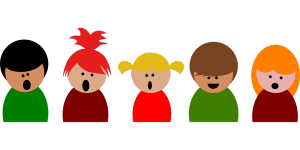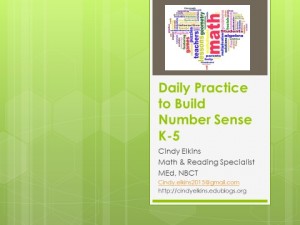by C. Elkins, OK Math and Reading Lady
This post will focus on ways to use a 100 chart to teach or review several math standards in the number sense and number operations strands (all grade levels). Each of these strategies can be completed in just a few minutes, making them perfect for your daily math meeting. Choose from counting, number recognition, number order, less/greater than, odd/even, addition, subtraction, multiplication, number patterns, skip counting, mental math, 1 more/less, 10 more/less, etc.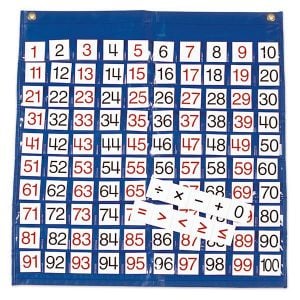
You can use a 1-100 chart poster on the smartboard, in poster form, or as a pocket chart. The pocket chart is the most versatile. See an example here: enasco.com pocket chart Here is also a link to little colored transparent pieces that can be placed in the pockets to highlight chosen numbers: enasco.com pocket chart transparent inserts I often show students that a 100 chart is actually just a giant number line all squished together instead of spread out across the room. To do this, I print off a chart, cut it into rows, tape the rows together, then highlight each multiple of 10. Second concept is that the lower numbers are at the top, and the higher numbers are at the bottom.
Counting, Number Order, and Place Value
- Instead of starting with a full 100 chart, start with an empty chart. Add 1 number per day in order, building toward the 100th day of school. This would be suggested for KG level.
- For other grade levels: Start with the numbers 1-10, 20, 30, 40, 50, 60, 70, 80, 90, and 100. Put the rest of the number pieces in a jar, baggy, or container. Draw one or more numbers at random each day and assist students in placing the number where it belongs. Example: If you draw out 45, let’s look at the one’s place (5) and know that it belongs in the same column as the 5. Let’s look at the ten’s place. We know it is greater than 40, but less than 50 so this helps us know which row it belongs in. As you progress, start using the currently placed numbers to help locate the new numbers. “I need to place 67. I see 57 is already on our chart and know that 67 is ten more, so I place it directly underneath.”
- Number Thief Game: After your chart is filled, try this game. After the children have left for the day, remove a few of the pieces. Then during your math meeting the next day, the children try to identify the missing numbers. Read how this blogger describes it: “Swiper” at petersons-pad.blogspot.com
- Number locating: Just practice locating numbers quickly. If asked to find 62, does the student start at 1 and look and look until they find it? Or can they go right to the 60s row?
- Place Value Pictures: You can’t do this on your hundred chart at meeting time, but there are dozens of picture-making worksheets available for free on TPT in which students follow coloring directions to reveal a hidden picture. Students get much better with locating numbers quickly with this type of practice.
Guess My Number: This is great for reviewing various number concepts. Here are a variations of guessing games. You can use with 1-100 chart, or 100-200, etc.
- Teacher writes a number secretly on a piece of paper (ex: 84). The teacher gives a single clue about the number, such as: “My number is greater than 50.” Then let 2-3 students guess the number. Confirm that they at least guessed a number greater than 50. Redirect if not. If you have the little colored inserts, place one in each of the incorrect numbers so students will know what was already guessed. If you don’t have those, just write the guessed numbers somewhere where students can see. Give a new clue after every 2-3 guesses until someone guesses the number. After guessing correctly, I always show the students the number I had originally written down so they will know I was on-the-level. Here are some example clues for the secret number 84: My number is even. In my number, the one’s place is less than the ten’s place. My number is less than 90. My number is greater than 70. If you add the 2 digits together, you get 12. The one’s digit is half of the ten’s digit. Again, affirm good guesses because at first there may be several numbers that fit your clue.
- Yes or No: This is almost a backward version of Guess My Number. Try this one after students are well-versed with the above game. It starts out the same though. Teacher selects a number. Then students have 10 tries to guess the number. They ask you questions, which can only be answered “yes” or “no.” Keep track on a chart paper of their questions and your answers. Some sample questions students could ask: Is your number even? Is your number greater than 50? Is your number in the sixties? Is your number less than 90? Are both of the digits even? Some higher level questions could deal with multiples (Is your # a multiple of 2? Is your number divisible by 4?)
Continue reading →


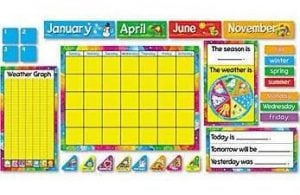
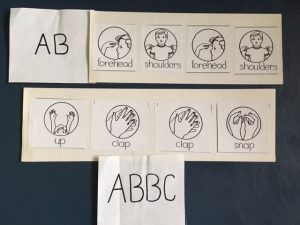 Introduce clap patterns which match your chosen calendar pattern. If you are working on AB, then do clap, snap . . . If you are working on ABC patterns, do clap, snap, touch your knees . . . Have children make up patterns to follow.
Introduce clap patterns which match your chosen calendar pattern. If you are working on AB, then do clap, snap . . . If you are working on ABC patterns, do clap, snap, touch your knees . . . Have children make up patterns to follow.